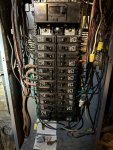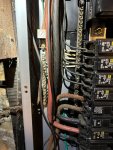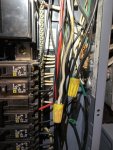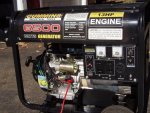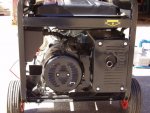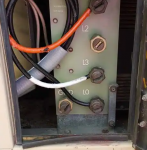Smithsonite
Member
- 23
- 52
- 13
- Location
- Central MA
Just began my install of my 802A for automatic standby use. Have some questions ...
I learned about this topic when I installed a portable diesel generator for automatic standby use at my dad's place last year - the fact that neutral / ground can only be bonded in ONE location, or else breakers will not trip. Also found out that there shouldn't be more than one ground rod in the ground, either. The generator at dad's (A Kubota GL7000) had a jumper connecting neutral to ground in the gen head, so I removed that, creating a floating neutral. Wiring connected the gen neutral & ground to the main panel & transfer switch in the proper locations. All is working well there.
I'm not an electrician, but I have a fairly solid understanding of how 2-pole household power works. My house seems odd. Every main panel I've ever seen has had an intermixing of neutrals and grounds. Here, we had a 200A main panel installed 19 years ago where they separated the neutral and ground completely. This is where my question / confusion comes in.
So, since there is no connection between neutral & ground in my main, nor any other panel, I'm thinking I can leave the bonding bar in place on my 802A, and things will be fine. The only thing here is I have a sub-panel in my barn that also has separated neutrals and grounds (The neutral in the sub connects to the main panel's neutral), but has a ground rod below the panel. My main panel also has a ground rod, along with another ground to the copper plumbing in the house. Are these 2 (Or technically 3, since we have well water) grounding points going to be an issue?
The other thing I was thinking about ... and I don't know if I'm correct or not ... but my thinking is that since the grounds and neutrals are separated in my main panel, in the event of a lightning strike to a utility pole, everything in my house would fry. I was thinking if I connected a large jump wire from neutral to ground in the main panel, that would allow that current to go to ground, vs. cooking everything I own. Not sure if my thinking is right on that.
That brings me to my 2nd question: Should I leave everything be, or remove the bonding bar in the 802A & instead bond neutral / ground in my main panel?
Getting a headache trying to figure all of this out. Thanks in advance!
I learned about this topic when I installed a portable diesel generator for automatic standby use at my dad's place last year - the fact that neutral / ground can only be bonded in ONE location, or else breakers will not trip. Also found out that there shouldn't be more than one ground rod in the ground, either. The generator at dad's (A Kubota GL7000) had a jumper connecting neutral to ground in the gen head, so I removed that, creating a floating neutral. Wiring connected the gen neutral & ground to the main panel & transfer switch in the proper locations. All is working well there.
I'm not an electrician, but I have a fairly solid understanding of how 2-pole household power works. My house seems odd. Every main panel I've ever seen has had an intermixing of neutrals and grounds. Here, we had a 200A main panel installed 19 years ago where they separated the neutral and ground completely. This is where my question / confusion comes in.
So, since there is no connection between neutral & ground in my main, nor any other panel, I'm thinking I can leave the bonding bar in place on my 802A, and things will be fine. The only thing here is I have a sub-panel in my barn that also has separated neutrals and grounds (The neutral in the sub connects to the main panel's neutral), but has a ground rod below the panel. My main panel also has a ground rod, along with another ground to the copper plumbing in the house. Are these 2 (Or technically 3, since we have well water) grounding points going to be an issue?
The other thing I was thinking about ... and I don't know if I'm correct or not ... but my thinking is that since the grounds and neutrals are separated in my main panel, in the event of a lightning strike to a utility pole, everything in my house would fry. I was thinking if I connected a large jump wire from neutral to ground in the main panel, that would allow that current to go to ground, vs. cooking everything I own. Not sure if my thinking is right on that.
That brings me to my 2nd question: Should I leave everything be, or remove the bonding bar in the 802A & instead bond neutral / ground in my main panel?
Getting a headache trying to figure all of this out. Thanks in advance!
Last edited:




